|
| |
| |
| |
[Documentation]

Edouard Manet
The jetty of Boulogne-sur-Mer 1868
| |
| |
| |
Catalogue of acquisitions: paintings and drawings
August 2001 - July 2002
This catalogue contains the paintings and drawings acquired by the Van Gogh Museum from August 2001 to July 2002. Each work has an inventory number made up as follows: the first letter stands for the technique (s = painting, d = drawing); this is followed by a reference number and then by a capital letter (B = loan, N = State of the Netherlands, S = Van Gogh Museum [after 1 July 1994], V = Vincent van Gogh Foundation) and the year of acquisition.
| |
Paintings
Manet, Edouard French 1832-1883
The jetty of Boulogne-sur-Mer 1868 Oil on canvas, 59.5 × 73.3 cm
Signed at lower right (on the buoy): Manet
s 507 S/2002
Manet's reputation as a painter of seascapes was established in 1864, when he produced his first great essays in the genre at Boulogne-sur-Mer, near Calais.Ga naar voetnoot1 Although his seascapes were innovative from the outset, he subsequently neglected the subject, not tackling it again until the summer of 1868 when he returned to the same seaside resort - whose popularity with the Parisian beau monde had considerably increased in the meantime.Ga naar voetnoot2 The artist recorded his impressions in a sketchbook, which he then used in his hotel room - or later in his Paris studio - to compose a range of harbour views, beach scenes and seascapes.Ga naar voetnoot3
This group includes The jetty of Boulogne-sur-Mer - the first painting by Manet in the Van Gogh Museum's collection.Ga naar voetnoot4 The central motif is formed by the two jetties at the mouth of the Liane, which gave access to Boulogne harbour further along the river. Were one to compare the painted scene to the site itself, the direction of view would be to the south, with the eastern jetty in the foreground and the coast invisible to the left.
The figures leaning over the railing are admiring a pleasure craft located between the two jetties, which partially obscure its form. The silhouette of the hull is just visible through the timber supports, revealing the boat to be relatively low and small, with a forward-pointing bowsprit. It is most probably a centreboard, a type of vessel developed in America around 1840.Ga naar voetnoot5 The boat is clearly moored, as the gaff is somewhat lowered and the boom raised - the standard method for drying sails without catching too much wind.
The jetty of Boulogne-sur-Mer appears to have been painted over an earlier picture, partially revealed with the aid of raking light, infrared reflectography and radiography. It was probably a seascape with a lighthouse and ships, painted with the canvas rotated 90 degrees to the right.Ga naar voetnoot6 This first work was originally larger; at some point, however, the canvas was cut down to its current format and relined.Ga naar voetnoot7 It was then transferred to a so-called figure 20 stretcher, measuring 73 × 60 cm. Manet probably intended to work further on the remaining portion of the original picture, as he had done with such works as The waitress (London, National Gallery) and In the café (Winterthur, Sammlung Oskar Reinhart), but nothing ever came of this.Ga naar voetnoot8
The build-up of the painting now visible is complex and will only be precisely understood following detailed technical examination. However, we can be fairly certain it was painted in several sessions. The boats to the left were part of the initial composition. They were originally accompanied by a moderately large sailing boat at the far right, which the artist subsequently painted out. It is difficult to tell if the foremost jetty formed part of the first design, but the rear jetty definitely appears to have been an afterthought, as the artist painted both it and the sailing ship to the right over the sea. Clearly, Manet could never resist making small changes, and this becomes obvious when we look at the edges of the canvas. At some time during the painting process, when he had already executed the foreground pier, he covered these edges with brown paper, as was usual for relined canvases. Apparently, the artist regarded his work as finished at this point, but he later returned to it, making various new amendments whereby he painted over the tape.Ga naar voetnoot9
In composing the scene Manet made use of his drawings; these sometimes served as mere aides-memoires but were occasionally literally copied. The wooden jetty in the foreground, for example, is
| |
| |

fig. 1
Edouard Manet, Study of the foundations of the eastern jetty, 1868, Paris, Musée du Louvre, Cabinet des Dessins

fig 2
Edouard Manet, Study of figures along the railings, 1868, Paris, Musée du Louvre, Cabinet des Dessins
simply inspired by the artist's previous sketches of the motif (fig. 1), as is the group of people against the railings at the rear, Ga naar voetnoot10 while the man with the telescope (fig. 2), the girl with the straw hat in the centre and the woman with a parasol at the far right (figs. 3 and 4) have been lifted in their entirety from the pages of a sketchbook. The latter figure also appears in a beach scene painted in the same period (Richmond, Virginia Museum of Fine Arts). Ga naar voetnoot11 Although there are no known drawings of the boat in the centre, it is not inconceivable that these once existed.
The charm of the painting lies to a large extent in Manet's treatment of the main motif, the two jetties.Ga naar voetnoot12 The artist has painted these horizontally across the canvas, a simple yet bold presentation of the subject that he undoubtedly derived from Japanese prints, which often feature such horizontal compositions (fig. 5).Ga naar voetnoot13 The spatial distribution of the other elements also suggests Manet drew his inspiration from this recently discovered source. While the foreground jetty is depicted at eye level, head on, the rear jetty is viewed from a raised viewpoint, as is the horizon, indicating that Manet preferred a stage-like arrangement of fore- and background to correct perspective, a choice undoubtedly influenced by Japanese models.
In the foremost jetty Manet also introduced an almost whimsical effect with the rhythmic repetition of the crossed supports. This was based on his drawings of the motif, in which the promenade jetty is depicted from an angle (fig. 1).Ga naar voetnoot14 In the painting, however, this element is presented frontally, creating an entirely artificial impression. This shows that in composing his picture Manet was guided principally by pictorial considerations. His objective was to achieve a kind of ‘constructed’ naturalness, which is why all attempts to understand The jetty of Boulogne-sur-Mer as a faithful rendering of the actual location are doomed to failure.Ga naar voetnoot15 As such the painting can be usefully compared with two other works of the same period, On the beach of Boulogne-sur-Mer (Richmond, Virginia Museum of Fine Arts) and Moon above the harbour of Boulogne-sur-Mer (Paris, Musée d'Orsay), which were also assembled from drawings.
Although the painting's power lies chiefly in Manet's representation of the jetty, certain details also claim our attention. The northern area of sea is finely rendered in the artist's distinctive blue-green, while the figures leaning forwards in the centre are confidently depicted with just a few fluent brushstrokes, as are the boats in the background - demonstrations of Manet's virtuosity as a painter. The work is both detailed and schematic, and, as far as the composition is concerned, the interplay of horizontal, vertical and diagonal lines is particularly sophisticated.Ga naar voetnoot16
Manet's horizontal representation of the jetty creates a virtually symmetrical picture, but the artist has countered any suggestion of monotony with a number of clever devices, such as the introduction
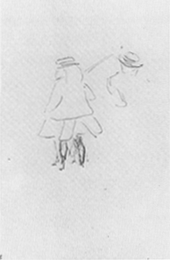
fig. 3
Edouard Manet, Girl seen from behind, 1868, Paris, Musée du Louvre, Cabinet des Dessins
of subtle variations in his depiction of the figures. The man in dark clothing with a telescope to the left is shown from the side; the woman and the boy are presented frontally; while the group in the centre is viewed from the back. Manet also offsets the uniformity of the railings on the foremost jetty by representing the standards of the rear railings in a fine yet actually illogical rhythm of light and dark tones. In order to prevent this effect from itself becoming symmetrical and thus tedious, he limited his use of it to the left and centre of the jetty - accepting that to the right only the railings on one side could be seen, as with the railings in the background. He also made the boat to the right dark in colour, in order to counterbalance the light-coloured vessels to the left, while the jetty in the foreground only casts a shadow on the water on one side.
In 1873 Manet sold The jetty of Boulogne-sur-Mer for 500 francs to the Paris art dealer Paul Durand-Ruel.Ga naar voetnoot17 It was
subsequently acquired by Félix Gérard, another dealer, who in 1884 loaned it to the Manet retrospective at the Ecole des Beaux-Arts, where it was hung above the famous painting
| |
| |
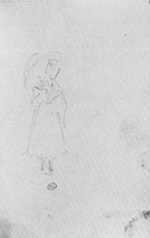
fig 4
Edouard Manet, Young woman with a parasol, 1868, Paris, Musée du Louvre, Cabinet des Dessins
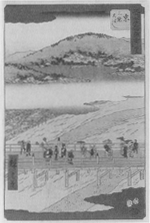
fig. 5
Utagawa Hiroshige, Miyako: the great Sanjō bridge, Amsterdam, Van Gogh Museum, gift of the Tōkyō Shimbun
Le bon bock of 1873 (Philadelphia Museum of Art and fig. 6). Ga naar voetnoot18 Gérard died in 1904 and in that year the seascape came into the possession of the prominent Dresden collector Oscar Schmitz (fig. 7). Swiss by origin, Schmitz began acquiring impressionist paintings in 1899, subsequently developing an interest in post-impressionism and contemporary German art. Ga naar voetnoot19 Although it was expected that a portion of Schmitz's collection, comprising 96 paintings and 61 drawings and lauded as ‘the finest private collection of modern French painting in Europe,’ Ga naar voetnoot20 would eventually find a home in the Gemäldegalerie, the collector could not agree terms with the museum's directors. Schmitz died in 1933; three years later his heirs sold the majority of the French pictures, including this one, to the Paris art dealers Wildenstein. Ga naar voetnoot21 The perfumer and collector Jacques Guérlain later purchased it from their gallery sometime between 1951 and 1955. Ga naar voetnoot22
Louis van Tilborgh
Provenance Acquired from Manet in 1873 by Paul Durand-Ruel for 500 francs, sold to Félix Gérard before 1884, in 1904 purchased by Oscar Schmitz, in 1936 sold to Wildenstein, Paris, sometime between 1951-55 bought by Jacques Guérlain, subsequently entered an anonymous private collection, acquired by the Van Gogh Museum through Giraud-Pissarro-Segalot (Paris and New York) with funds provided by the SponsorBingo Lottery, the Vereniging Rembrandt (supported by the Prins Bernhard Cultuurfonds), the VSB Foundation, the Mondriaan Foundation, the Vincent van Gogh Foundation, the Rabobank and the Ministry of Education, Culture and Science
Literature Lionello Venturi, Les archives de l'impressionisme Lettres de Renoir, Monet, Pissarro, Sisley et autres Mémoires de Paul Durand-Ruel Documents, 2 vols, New York 1968, vol 2, pp 191-92, Denis Rouart and Daniel Wildenstein, Edouard Manet catalogue raisonné, 2 vols, Lausanne & Paris 1975, vol 1, no 145, Françoise Cachin et al, exhib cat Manet 1832-1883. Paris (Galeries nationales du Grand Palais) & New York (The Metropolitan Museum of Art) 1983, pp 312-13, no 119, Robert L Herbert, Impressionism art, leisure, and Parisian society, New Haven & London 1988, pp 274-75, Heike Biedermann, ‘Die Sammlungen Adolf Rothermundt und Oscar Schmitz in Dresden,’ in Adreas Pophanken and Felix Billeter, Die Moderne und ihre Sammler Franzosische Kunst in Deutschem Privatbesitz vom Kaiserreich zur Weimarer Republik, Berlin 2001, pp 213-14, fig 39 on p 215, p 231, note 19

fig. 6
Godet, photograph of the Exposition des oeuvres d'Edouard Manet in 1884, Paris, Bibliothèque Nationale, Cabinet des Estampes
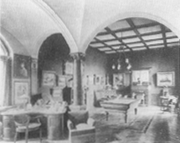
fig. 7
Photograph of the salon of Oscar Schmitz's villa in Dresden, c. 1920, private collection
| |
| |
| |
Drawings
Bonvin, François
French, 1817-1887
Woman by a stove 1857 Charcoal, 35.0 × 27 9 cm
Signed at lower right, f. Bonvin Dated at lower left: 1857
d 1114 S/2002
The subjects François Bonvin represented in his paintings, drawings and watercolours remained largely consistent from the beginning of his artistic career in the 1840s until his death in 1887. In addition to portraits and still lifes, he principally drew and painted craftsmen and women performing their household tasks. Bonvin derived inspiration for these works from the Dutch and Flemish masters of the 17th century, and 18th-century artists such as Chardin and the Le Nain brothers. Unlike his contemporary Courbet, Bonvin never used a large format or dramatic style for these works, saving him from some of the harsher critiques directed at the realists in general. He was popular with the critics and even received state commissions.
The charcoal drawing Woman by a stove depicts a young woman, seen in profile, stoking up a fire with a pair of bellows. Bonvin has drawn this tranquil scene in a highly subtle manner, particularly the model's clothing with all its folds, the gleaming copper of the saucepan on the stove and the steam rising from the pan against the black background on the left. This dark area is echoed in the foreground by the woman's black skirt. Both elements form a strong contrast with the brightly lit foreground, the woman's white blouse and cap, and the wall behind her to the right. The drawing's serene mood, simple composition and striking chiaroscuro are characteristic of Bonvin's work. Dated 1857, it comes from what is generally considered his best period.
The same model, wearing the same clothing, appears in a black chalk drawing and a watercolour from 1856 (Weisberg, nos. 253-54). She is also shown in profile in these two works, this time while eating.
Woman by a stove is the first drawing by Bonvin to enter the Van Gogh Museum's collection. Previously, the artist was only represented by a painting, Still life with drawing equipment (s 431 M/1992), acquired in 1992.
Marije Vellekoop
Provenance Commenge, before 1926, Brame, 1926,
M Tempelaere (1927), W Minderman, The Hague, acquired by the Van Gogh Museum (2002)
Literature E Moreau-Nélaton, Bonvin raconté par lui-même, Paris 1927, p 55, fig 27, G P Weisberg, Bonvin, Paris 1979, p 268, no 258
| |
Daubigny, Charles-François
French, 1817-1878
Flock of sheep by moonlight 1859
Charcoal, pen and ink, gouache, 23.2 cm × 51.0 cm
Signed at lower right: Daubigny
d 1115 S/2002
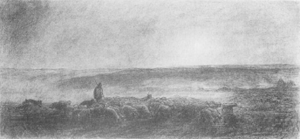
Landscapes by moonlight form a special category in Daubigny's oeuvre. He painted a number of them, particularly at the end of his career, and was represented by a moonlit landscape at every exhibition in which he participated in 1877 and 1878. As in Daubigny's other landscapes, farmers and their livestock, small peasant dwellings or shepherds with flocks of sheep generally populate these scenes. He preferred to paint and draw his evening landscapes in a long, rectangular format, the width of these works being at least twice their height. Daubigny began using this panorama format in the late 1850s, the period in which he produced our newly acquired drawing.
The drawing shows a vast moonlit plain, across which a shepherd and his flock move from left to right. Two dark-coloured dogs drive the sheep, one bounding around at the far left, the other close behind the shepherd. The man stands out as a dark figure against the misty background; he carries a staff over one shoulder and a coat over the other. The moonlight reflects off the animals' heads and backs. To the right are two small groups of haystacks.
The drawing is executed in charcoal. The contours of the sheep, the shepherd, the haystacks and several major lines in the landscape have been drawn over in pen and black ink. The artist has left areas of the cream-coloured paper blank in rendering the light on the animals' backs, although he uses white gouache to represent the pale moon.
The subject, composition and proportions of this work strongly resemble those of a painting from 1859, which is only known from reproductions. It was Daubigny's first landscape by moonlight, measuring 88.5 × 193 cm, which he exhibited at the Salon of 1859. The artist would again use the same composition in 1877, although in this canvas, Lever de lune à Auvers, now in the Museum of Fine
| |
| |
Arts in Montreal, he set the flock of sheep somewhat further back in the picture plane and placed a row of three haystacks on the right. The format of this painting is 106.5 × 188 cm, making it considerably less elongated than the 1859 work.
The similarities between the drawing and the painting from 1859 on the one hand, and the 1877 painting on the other, suggest that the earlier landscapes were also produced in Auvers-sur-Oise, as the title of the later piece indicates. Daubigny would settle in this little town just outside Paris in 1860.
The Van Gogh Museum's collection has always included two small sketches by Daubigny that once

belonged to Theo and Vincent van Gogh. Thanks to the acquisition of Flock of sheep by moonlight the artist is now represented by a finished work that is highly characteristic of his oeuvre.
Marije Vellekoop
Provenance W Minderman, The Hague, acquired by the Van Gogh Museum (2002)
Literature Robert Hellebrandth, Charles-François Daubigny 1817-1878, Morges 1976, Sonja Klee, Charles-François Daubigny (1817-1878) Die Mondscheinlandschaften (diss, Koblenz 1996)

| |
Jansen, Hendricus
Dutch, 1867-1921
Figure for the left wall painting in the period room in Museum Mesdag
Blue chalk, brush in black ink, gouache, watercolour and white oil, 90 × 28 cm
Signed at lower right with monogram in brush in black ink: HH
d 1117 S/2002
Figure for the right wall painting in the period room in Museum Mesdag
Blue chalk, brush in black ink, gouache and watercolour, 90 × 28 cm
Signed at lower left with monogram in brush in black ink: HH
d 1116 S/2002
In 2002 the Van Gogh Museum acquired two drawings of Buddha figures made by the Hague artist Hendricus Jansen for the Museum Mesdag. The drawings are one-to-one cartoons for the wall panels installed above the fireplace in the museum's period room around 1916. H.W. Mesdag's private house, now part of the museum, was sold after his death in 1915 to the Bond van Eigenaren van de Nederlandsch-Indische Suiker Ondernemingen (BENISO). This organisation refurbished the painter's former studio on the first floor, transforming it into a boardroom in Art Nouveau style, the epitome of modern design at the time. Jansen was asked to design both stained-glass windows and three wall panels to hang above the fireplace in the new office.
Hendricus Jansen, who generally signed his work ‘Henricus,’ was a celebrated painter, much in demand around 1915. He produced both illustrations and monumental decorations, carrying out commissions from the Carnegie Foundation for wall paintings in the Vredespaleis, and from the local authorities of The Hague and Rotterdam for decorations in the municipal theatre and town hall, respectively. Jansen trained at the Haagse Academie voor Beeldende Kunsten. He then moved to Paris, where he found work as an illustrator for periodicals like Le Chat Noir, Le Monde Illustré and Echo de Paris. Back in the Netherlands he continued to produce illustrations for publications such as the Spectator. His best-known illustrations were for the 1904 reissue of a medieval work, the so-called Liedeke van Heer Halewyn. Jansen, who died in 1921, during his work on the Rotterdam town hall,
| |
| |
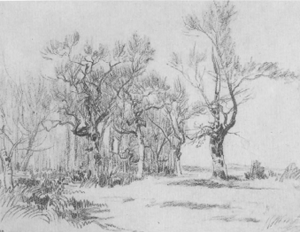
is now a virtually forgotten artist. However, at the turn of the last century he was one of the most renowned figures of Dutch symbolism and Jugendstil. Jansen was a close friend of the painter Willem Adriaan van Koijnenburg (1868-1943).
Maartje de Haan
Provenance Private collection; acquired by the Van Gogh Museum (2002)
| |
Rousseau, Théodore
French, 1812-1867
Lisière du Bas-Bréau, Fontainebleau, winter effect c. 1845?
Charcoal on blue paper, 47.5 × 61 5 cm
Signed at lower left with studio stamp: TH.R
d 1112 S/2001
Although he received a traditional artist's training, Théodore Rousseau developed his original approach to landscape by working directly from nature. Even as a student, he went into the countryside in search of motifs. From 1836 onwards Rousseau worked mainly in Barbizon, together with Diaz, Decamps and especially Dupré, with whom he travelled to Les Landes and the Pyrenees in 1844. Rousseau strongly identified with the natural world he painted, making it his goal to depict what he described as ‘the soul of the forest.’ In 1853 he petitioned the local authorities to protect the forest of Fontainebleau from exploitation. Despite being generally acknowledged as the guiding light of the so-called School of 1830, Rousseau lived in almost unrelenting poverty.
Only after the artist's death did it emerge that he had produced many drawings as well as paintings. The catalogue for the auction of his collection, held a year after his death, lists no fewer than around 1200 drawings. Although many of these are associated with paintings, they go beyond the concept of preliminary studies and are works of art in themselves.
According to the inscription on the verso, this large charcoal drawing represents the edge of the woods at Bas-Bréau, in the forest of Fontainebleau. It has been suggested that the work belongs to a series of drawings and oil studies associated with Rousseau's famous painting La forêt en hiver, au coucher de soleil (New York, The Metropolitan Museum). This painting, on which the artist worked from 1846 until his death, shows a clearing in a forest surrounded by dense groups of trees. However, there is such a great contrast between the enclosed character of the painting and the openness of this drawing that any direct relationship between the two seems out of the question. Nevertheless, an indirect connection could be inferred from the similarities in size, drawing material, paper colour and drawing style between this drawing and a work in the Louvre, whose subject strongly resembles that of the painting. Both the large format and paper colour are virtually unique in Rousseau's drawn oeuvre.
The dating of Rousseau's drawings is generally problematic, as they are usually undated, and the drawing style and technique do not lend themselves easily to chronological classification. Neither do the locations depicted offer any assistance, as the artist continually returned to his favourite spots. Nor would any relationship with the painting cited above provide a solution in the case of our drawing, for Rousseau worked on the canvas for more than 20 years. In his catalogue of Rousseau's works, Schulman dates the drawing in the Louvre to circa 1845, a date that could also be applied to the museum's newly acquired drawing, given the similarities between the two works.
Thanks to this acquisition the Van Gogh Museum now owns a drawing by Rousseau as well as a painting. The drawing will be included in the supplement to Michel Schulman's catalogue raisonné.
Marije Vellekoop
Provenance Artist's studio, sale Th Rousseau collection, Paris (Maitre Pillet), 27-30 April 1868, sale Charles Tillot collection, Paris, 14 May 1887; private collection, France, W M Brady & Co, Inc, New York, acquired by the Van Gogh Museum (2001)
Literature exhib cat Theodore Rousseau 1812-1867, Paris (Musée du Louvre) 1967-68, Michel Schulman, Théodore Rousseau 1812-1867 Catalogue raisonné de l'oeuvre graphique, Paris 1997
|
-
voetnoot1
- I would like to express my heartfelt thanks to Juliet Bareau, without whose help this text could not have been written - Louis van Tilborgh
It is possible that Manet had known Boulogne even before this Ronald Pickvance has suggested it was the favourite holiday resort of Manet's parents, see exhib cat Edouard Manet, Martigny (Fondation Pierre Gianadda) 1996, p 223, no 25
-
voetnoot2
- Boulogne boasted easy accessibility, with a direct train line from Paris to Calais that was extended to Boulogne itself in 1867, see Theodore Reff, exhib cat Manet and modern Paris 100 paintings, drawings, prints, and photographs by Manet and his contemporaries, Washington (National Gallery of Art) 1982, pp 152-53 In 1871 Manet would again stay in Boulogne, where he painted The croquet match (Denis Rouart and Daniel Wildenstein, Edouard Manet catalogue raisonné, 2 vols, Lausanne & Paris 1975, vol 1, no 173)
-
voetnoot3
- In Rouart and Wildenstein (op cit (note 2), vol 1, nos 143-50) 1869 is the date adduced for this first visit to the seaside resort and thus for The jetty of Boulogne-sur-Mer (no 145) This dating (originally derived from Théodore Duret, Historie d'Edouard Manet et de son oeuvre, Paris 1902, p 221, no 116) was subsequently adopted in Françoise Cachin et al, exhib cat
Manet 1832-1883, Paris (Galeries nationales du Grand Palais) & New York (The Metropolitan Museum of Art) 1983, pp 312-13, no 119, but it is incorrect, as shown by the correspondence included in the catalogue (p 151) For Manet's correspondence during his 1868 stay see also Juliet Wilson-Bareau, Manet par lui-même correspondance et conversations, peintures, pastels, dessins et estampes, Paris 1991, pp 47-49 Rouart and Wildenstein, op cit (note 2), vol 1, attribute eight paintings to this visit (nos 143-150) Five of these were composed with the aid of the sketchbooks, but for three works - nos 144, 149 and 150 - this has proved impossible to establish The 1868 dating of the five works is based on the reasonable assumption that Manet worked his drawings from the seaside resort into paintings while still in Boulogne or shortly after his return to Paris
-
voetnoot4
- Before this purchase Dutch museums owned only two works by Manet One is a portrait of a man from 1860 (Otterlo, Kroller-Muller Museum), the other a still life with flowers (Rotterdam, Museum Boijmans van Beuningen), which, however, is not included in Rouart and Wildenstein, op cit (note 2), see Aukje Vergeest, The French collection 19th-century French paintings in Dutch public collections, Amsterdam 2000, p 217, nos 656-57
-
voetnoot5
- Robert L Herbert wrongly believed this was a fishing boat, which Manet had simply rendered incorrectly, see idem, Impressionism art, leisure, and Parisian society, New Haven & London 1988, pp 274-75 The centreboard was a fairly wide, flat vessel, designed to glide over the water, with a board that could be lowered through the keel to prevent leeway In addition to the mainsail, the craft in the painting has two head-sails and a gaff topsail, which has been lowered With thanks to Kees Posthuma (Van Gogh Museum) and Anton Kos (Het Zuiderzee Museum)
-
voetnoot6
- This and other technical information has been supplied by René Boitelle (Van Gogh Museum) That the jetty had a lighthouse is indicated by Manet's watercolours of the motif, published in exhib cat Von Linie und Farbe Franzosische Zeichungen des 19 Jahrhunderts aus der Graphishen Sammlung im Städel und aus Frankfurter Privatbesitz, Frankfurt am Main (Stadelsches Kunstinstitut und Städtische Galerie) 2001-02, pp 72-73, no 29
-
voetnoot7
- The other part of the original picture has not been preserved or cannot been identified as such in Manet's oeuvre
-
voetnoot8
- These two works of 1878, which were also provided with a paste relining on Manet's instruction, originally formed one and the same picture, see David Bomford and Ashok Roy, ‘Manet's The waitress an investigation into its origin and development,’ National Gallery Technical Bulletin 7 (1983), pp 3-20, particularly pp. 4-13 For Manet's painting process see Juliet Wilson-Bareau, The hidden face of Manet an investigation of the artist's
working processes, London 1986.
-
voetnoot9
- He did the same with The waitress and In the café, see Bomford and Roy, op cit (note 8), pp 6 and 8 In The jetty of Boulogne-sur-Mer the artist painted over the tape near the railings and the sky, although it is unclear whether the additions in the latter area are actually by Manet's hand
-
voetnoot10
- Rouart and Wildenstein, op cit (note 2), vol 2, nos 139, 142-44 These works and the drawings mentioned in note 11 have the same format, from which it may be inferred that they all come from the same sketchbook (or drawing pad) Only no 139 is smaller, but it was probably cut down at a later stage The jetty is also depicted in two watercolours in a sketchbook that has been preserved intact, see Von Linie and Farbe, cit (note 6), pp 72-73
-
voetnoot11
- See Rouart and Wildenstein, op cit (note 2), vol 2, nos 140, 146, and 200 The beach scene, currently in the Virginia Museum of Fine Arts in Richmond, is discussed in Alain De Leiris, ‘Manet Sur la plage de Boulogne,’ Gazette des Beaux-Arts 57 (January 1961), pp 53-62
-
voetnoot12
- Jetties had been introduced as a subject during the 1850s by Eugène Boudin, see Vivian Hamilton, Boudin at Trouville, London & Glasgow 1993, pp 91-98
-
voetnoot13
- Manet's admiration for Japanese prints is discussed in Jacques Dufwa, Winds from the East a study in the art of Manet, Degas, Monet, Whistler, 1856-86, Stockholm 1981, pp 51-82
-
voetnoot14
- This indicates that Manet made his sketches from the beach, where he would have viewed the jetty from an angle
-
voetnoot15
- For example, Manet seems to have added the figures on the rear jetty simply to bring life to the composition, this southerly jetty could not be accessed from the beach, only from a desolate area of dunes where tourists presumably never set foot, as appears from an 1844 map of the resort (Boulogne-sur-Mer, Bibliothèque Municipale)
-
voetnoot16
- As part of this interplay Manet probably manipulated his representation of the sailing boat's rigging to suit his needs He angled the backstay too far to the rear, a position from which it would have been impossible to change tack He also depicted the crosstree in profile, although on a real boat this can only be seen from the rear
-
voetnoot17
- According to Rouart and Wildenstein, op cit (note 2), vol 1, no 145, Durand-Ruel acquired the work from Manet in 1872, together with an unknown number of other paintings, for which he paid a total of 16,000 francs However, this information, based on the dealer's recollections (published by Lionello Venturi in Les archives de l'impressionisme Lettres de Renoir, Monet, Pissarro, Sisley et autres Mémoires de Paul Durand-Ruel Documents, 2 vols, New York 1968, vol 2, p 192) does not appear to be correct Durand-Ruel was mistaken as to the year and apparently confused the painting with another view of the same jetty, painted at the same time, which he would later sell to the collector Léon Clapisson (see ibid, p 191, and Rouart and Wildenstein, op cit [note 2], vol 1, no 144) Still unknown at the time was Manet's account book, a copy of which had been made by his brother-in-law, Léon Leenhoff (Paris, Bibliothèque Nationale, p 75) This shows that the work was actually sold to Durand-Ruel for 500 francs in 1873, he subsequently entered it as number 2671 in his Livre de stock 1868-1873 Somewhere between 1883 and circa 1890, it was photographed on the instructions of Leenhoff, who presumably intended to compile a catalogue of the artist's work (New York, Pierpont Morgan Library, Album II, p 76, no 443) The photograph bears an annotation in Leenhoff's hand ‘Peint à Boulogne sur mer ou à Calais - à Gérard’ This new information regarding the work's provenance was supplied by Juliet Bareau, to whom we are extremely grateful In Manet's account book the work is described as ‘Jetée de Boulogne’ and this title has persisted, although ‘The piers of Boulogne’ might be more accurate
-
voetnoot18
- A photograph of the installation was first published in Etienne Moreau-Nélaton, Manet raconté par lui-même, 2 vols, Paris 1926, vol 2, fig 344 Félix Laurent Joseph Gérard, who is recorded as the owner of the seascape in exhib cat Exposition des oeuvres d'Edouard Manet, Paris (Ecole nationale des Beaux-Arts) 1884, no 51, also owned another painting by Manet (Rouart and Wildenstein, op cit [note 2], vol 1, no 360) Gérard had a framing shop in the 1870s, but was listed as a marchand de tableaux on his death in 1904 (with thanks to Anne Distel, Paris, Musée d'Orsay)
-
voetnoot19
- The rest of Gérard's collection was auctioned in 1905 at the Hôtel Drouot (28-29 March) Apparently the painting was sold separately, although the form of the sale is not known Heike Biedermann (‘Die Sammlungen Adolf Rothermundt und Oscar Schmitz in Dresden,’ in Adreas Pophanken and Felix Billeter, Die Moderne und ihre Sammler Franzosische Kunst in Deutschem Privatbesitz vom Kaiserreich zur Weimarer Republik, Berlin 2001, pp 213-14) states that Schmitz bought The jetty of Boulogne-su-Mer at Durand-Ruel's gallery, but inquiry reveals this was based on an error Through exhib cat Collection Oskar Schmitz, Paris (Wildenstein) 1936, no 38 we know only that he acquired the painting in 1904 The Swiss collector hung the seascape in his salon, to the right of an unknown relief, with a Monet landscape to
the left (see also Biedermann, p 215, fig 39, and pp 214, 231, note 19)
-
voetnoot20
- Emil Waldmann, ‘Ein Gesamtbild Europaischer Kunst auf der Internationalen Kunstausstellung in Dresden,’ Bremer Nachrichten, 20 June 1926, quoted in Biedermann, op cit (note 19), p 220
-
voetnoot21
- After the failure of negotiations in 1931 Schmitz moved the collection from Dresden to Switzerland, where he loaned his French works to the Kunsthaus in Zurich See Biedermann, op cit (note 19), pp 221, 233, note 46, and Collection Oskar Schmitz cit (note 19)
-
voetnoot22
- In exhib cat Masterpieces festival of Britain, New York (Wildenstein) 1951, no 15, the Paris art dealer is still registered as the owner, but in exhib cat Tableaux des collections parisiennes, Paris (Ecole des Beaux-Arts) 1955, no 65, it is listed as belonging to a private collection Guérlain is first mentioned as the work's owner in Rouart and Wildenstein, op cit (note 2)
|














